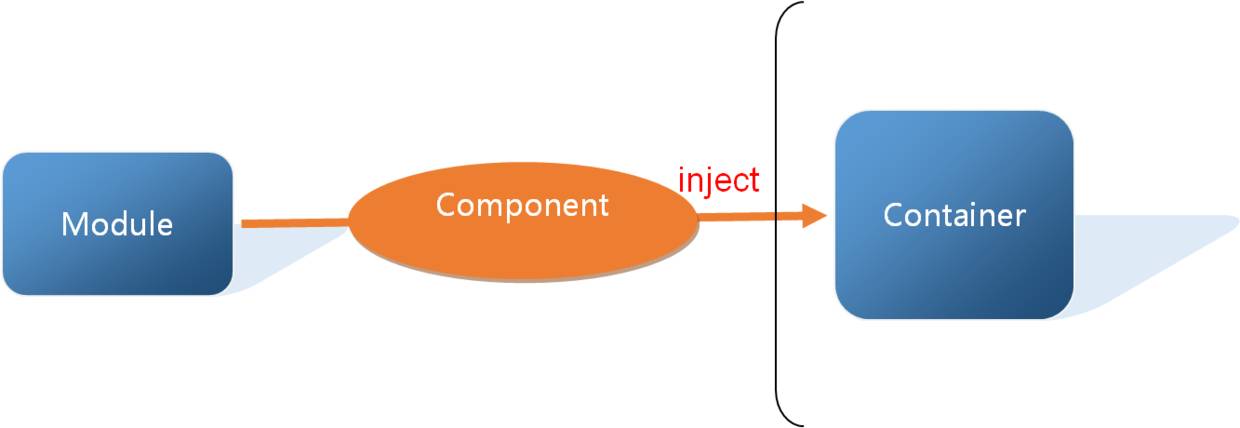前言
当前比较流行的Android开发框架当属MVP、RxJava、Retrofit2、Dagger2了,而在这些框架之中,学习成本最高也是最难上手的应该就是Dagger2了,因此网络上也是充斥了各式各样诸如下面的文章:
这些也都无非说明了Dagger2既火热又比较难于上手学习的问题。
但是作为程序员这种需要与时俱进的行业,毕竟不进步就是落后嘛,了解并掌握Dagger2还是是很有必要的。
Dagger2介绍
1. Dagger2是什么?
Dagger2在Github主页上的自我介绍是:“A fast dependency injector for Android and Java“(一个提供给Android和Java使用的快速依赖注射器。)
Dagger2是由谷歌接手开发,最早的版本Dagger1 是由Square公司开发的。
2. Dagger2相较于Dagger1的优势是什么?
更好的性能:相较于Dagger1,它使用的预编译期间生成代码来完成依赖注入,而不是用的反射。大家知道反射对手机应用开发影响是比较大的,因为反射是在程序运行时加载类来进行处理所以会比较耗时,而手机硬件资源有限,所以相对来说会对性能产生一定的影响。
容易跟踪调试:因为dagger2是使用生成代码来实现完整依赖注入,所以完全可以在相关代码处下断点进行运行调试。
3. 使用依赖注入的最大好处是什么?
没错,就是模块间解耦! 就拿当前Android非常流行的开发模式MVP来说,使用Dagger2可以将MVP中的V 层与P层进一步解耦,这样便可以提高代码的健壮性和可维护性。
如果在 Class A 中,有 Class B 的实例,则称 Class A 对 Class B 有一个依赖。
如果不用Dagger2的情况下我们应该这么写:
public class A {
...
B b;
... public A() {
b = new B();
}
}
上面例子面临着一个问题,一旦某一天B的创建方式(如构造参数)发生改变,那么你不但需要修改A中创建B的代码,还要修改其他所有地方创建B的代码。
如果我们使用了Dagger2的话,就不需要管这些了,只需要在需要B的地方写下:
@InjectB b;
Dagger2使用
上面我们对Dagger2有了个初步的了解,接下来我们来看看Dagger2的基本使用内容。
1. 注解
Dagger2 通过注解来生成代码,定义不同的角色,主要的注解如下:
@Module: Module类里面的方法专门提供依赖,所以我们定义一个类,用@Module注解,这样Dagger在构造类的实例的时候,就知道从哪里去找到需要的依赖。
@Provides: 在Module中,我们定义的方法是用这个注解,以此来告诉Dagger我们想要构造对象并提供这些依赖。
@Inject: 通常在需要依赖的地方使用这个注解。换句话说,你用它告诉Dagger这个类或者字段需要依赖注入。这样,Dagger就会构造一个这个类的实例并满足他们的依赖。
@Component: Component从根本上来说就是一个注入器,也可以说是@Inject和@Module的桥梁,它的主要作用就是连接这两个部分。将Module中产生的依赖对象自动注入到需要依赖实例的Container中。
@Scope: Dagger2可以通过自定义注解限定注解作用域,来管理每个对象实例的生命周期。
@Qualifier: 当类的类型不足以鉴别一个依赖的时候,我们就可以使用这个注解标示。例如:在Android中,我们会需要不同类型的context,所以我们就可以定义 qualifier注解“@perApp”和“@perActivity”,这样当注入一个context的时候,我们就可以告诉 Dagger我们想要哪种类型的context。
2. 结构
Dagger2要实现一个完整的依赖注入,必不可少的元素有三种:Module,Component,Container。
为了便于理解,其实可以把component想象成针管,module是注射瓶,里面的依赖对象是注入的药水,build方法是插进患者(Container),inject方法的调用是推动活塞。
3. 配置
Java Gradle
// Add plugin https://plugins.gradle.org/plugin/net.ltgt.apt
plugins {
id "net.ltgt.apt" version "0.5"
}
// Add Dagger dependencies
dependencies {
compile 'com.google.dagger:dagger:2.x'
apt 'com.google.dagger:dagger-compiler:2.x'
}
Android Gradle
// Add Dagger dependencies
dependencies {
compile 'com.google.dagger:dagger:2.x'
annotationProcessor 'com.google.dagger:dagger-compiler:2.x'
}
如果使用的Android gradle plugin 版本低于2.2请参考这里
4. 简单的例子
实现Module
继续上面的例子:
@Module // 注明本类是Module
public class MyModule{
@Provides // 注明该方法是用来提供依赖对象的方法
public B provideB(){
return new B();
}
}
实现Component
@Component(modules={ MyModule.class}) // 指明Component查找Module的位置
public interface MyComponent{ // 必须定义为接口,Dagger2框架将自动生成Component的实现类,对应的类名是Dagger×××××,这里对应的实现类是DaggerMyComponent
void inject(A a); // 注入到A(Container)的方法,方法名一般使用inject
}
实现Container
A就是可以被注入依赖关系的容器。
public A{
@Inject //标记b将被注入
B b; // 成员变量要求是包级可见,也就是说@Inject不可以标记为private类型。
public void init(){
DaggerMyComponent.create().inject(this); // 将实现类注入
}
}
当调用A的init()方法时, b将会自动被赋予实现类的对象。
5. 更多用法
方法参数
上面的例子@Provides标注的方法是没有输入参数的,Module中@Provides标注的方法是可以带输入参数的,其参数值可以由Module中的其他被@Provides标注的方法提供。
@Module
public class MyModule{
@Provides
public B provideB(C c){
return new B(c);
}
@Provides
pulic C provideC(){
return new C();
}
}
如果找不到被@Provides注释的方法提供对应参数对象的话,将会自动调用被@Inject注释的构造方法生成相应对象。
@Module
public class MyModule{
@Provides
public B provideB(C c){
return new B(c);
}
}
public class C{
@Inject
Public C(){
}
}
添加多个Module
一个Component可以添加多个Module,这样Component获取依赖时候会自动从多个Module中查找获取。添加多个Module有两种方法,一种是在Component的注解@Component(modules={××××,×××})中添加多个modules
@Component(modules={ModuleA.class,ModuleB.class,ModuleC.class})
public interface MyComponent{
...
}
另外一种添加多个Module的方法可以使用@Module的 includes的方法(includes={××××,×××})
@Module(includes={ModuleA.class,ModuleB.class,ModuleC.class})
public class MyModule{
...
}@Component(modules={MyModule.class})
public interface MyComponent{
...
}
创建Module实例
上面简单例子中,当调用DaggerMyComponent.create()实际上等价于调用了DaggerMyComponent.builder().build()。可以看出,DaggerMyComponent使用了Builder构造者模式。在构建的过程中,默认使用Module无参构造器产生实例。如果需要传入特定的Module实例,可以使用
DaggerMyComponent.builder()
.moduleA(new ModuleA())
.moduleB(new ModuleB())
.build()
区分@Provides 方法
这里以Android Context来举例。当有Context需要注入时,Dagger2就会在Module中查找返回类型为Context的方法。但是,当Container需要依赖两种不同的Context时,你就需要写两个@Provides方法,而且这两个@Provides方法都是返回Context类型,靠判别返回值的做法就行不通了。这就可以使用@Named注解来区分
//定义Module
@Module
public class ActivityModule{
private Context mContext ;
private Context mAppContext = App.getAppContext();
public ActivityModule(Context context) {
mContext = context;
}
@Named("Activity")
@Provides
public Context provideContext(){
return mContext;
}
@Named("Application")
@Provides
public Context provideApplicationContext (){
return mAppContext;
}
}
//定义Component
@Component(modules={ActivityModule.class})
interface ActivityComponent{
void inject(Container container);
}
//定义Container
class Container extends Fragment{
@Named("Activity")
@Inject
Context mContext;
@Named("Application")
@Inject
Context mAppContext;
...
public void init(){
DaggerActivityComponent.
.activityModule(new ActivityModule(getActivity()))
.inject(this);
}
}
这样,只有相同的@Named的@Inject成员变量与@Provides方法才可以被对应起来。
更常用的方法是使用注解@Qualifier来自定义注解。
@Qualifier
@Documented //起到文档提示作用
@Retention(RetentionPolicy.RUNTIME) //注意注解范围是Runtime级别
public @interface ContextLife {
String value() default "Application"; // 默认值是"Application"
}
接下来使用我们定义的@ContextLife来修改上面的例子
//定义Module
@Module
public class ActivityModule{
private Context mContext ;
private Context mAppContext = App.getAppContext();
public ActivityModule(Context context) {
mContext = context;
}
@ContextLife("Activity")
@Provides
public Context provideContext(){
return mContext;
}
@ ContextLife ("Application")
@Provides
public Context provideApplicationContext (){
return mAppContext;
}
}
//定义Component
@Component(modules={ActivityModule.class})
interface ActivityComponent{
void inject(Container container);
}
//定义Container
class Container extends Fragment{
@ContextLife ("Activity")
@Inject
Context mContext;
@ContextLife ("Application")
@Inject
Context mAppContext;
...
public void init(){
DaggerActivityComponent.
.activityModule(new ActivityModule(getActivity()))
.inject(this);
}
}
组件间依赖
假设ActivityComponent依赖ApplicationComponent。当使用ActivityComponent注入Container时,如果找不到对应的依赖,就会到ApplicationComponent中查找。但是,ApplicationComponent必须显式把ActivityComponent找不到的依赖提供给ActivityComponent。
//定义ApplicationModule
@Module
public class ApplicationModule {
private App mApplication;
public ApplicationModule(App application) {
mApplication = application;
}
@Provides
@ContextLife("Application")
public Context provideApplicationContext() {
return mApplication.getApplicationContext();
}
}
//定义ApplicationComponent
@Component(modules={ApplicationModule.class})
interface ApplicationComponent{
@ContextLife("Application")
Context getApplication(); // 对外提供ContextLife类型为"Application"的Context
}
//定义ActivityComponent
@Component(dependencies=ApplicationComponent.class, modules=ActivityModule.class)
interface ActivityComponent{
...
}
6. 进阶用法
单例的使用
创建某些对象有时候是耗时、浪费资源的或者需要确保其唯一性,这时就需要使用@Singleton注解标注为单例了。
@Module
class MyModule{
@Singleton // 标明该方法只产生一个实例
@Provides
B provideB(){
return new B();
}
}
@Singleton // 标明该Component中有Module使用了@Singleton
@Component(modules=MyModule.class)
class MyComponent{
void inject(Container container)
}
※注意:Java中,单例通常保存在一个静态域中,这样的单例往往要等到虚拟机关闭时候,该单例所占用的资源才释放。但是,Dagger通过注解创建出来的单例并不保持在静态域上,而是保留在Component实例中。所以说不同的Component实例提供的对象是不同的。
自定义Scope
@Singleton就是一种Scope注解,也是Dagger2唯一自带的Scope注解,下面是@Singleton的源码
@Scope
@Documented
@Retention(RUNTIME)
public @interface Singleton{}
可以看到定义一个Scope注解,必须添加以下三部分:
@Scope :注明是Scope
@Documented :标记文档提示
@Retention(RUNTIME) :运行时级别
对于Android,我们通常会定义一个针对整个APP全生命周期的@PerApp的Scope注解和针对一个Activity生命周期的@PerActivity注解,如下
@Scope
@Documented
@Retention(RetentionPolicy.RUNTIME)
public @interface PerApp {
}
@Scope
@Documented
@Retention(RetentionPolicy.RUNTIME)
public @interface PerActivity {
}
@PerApp的使用例:
@Module
public class ApplicationModule {
private App mApplication;
public ApplicationModule(App application) {
mApplication = application;
}
@Provides
@PerApp
@ContextLife("Application")
public Context provideApplicationContext() {
return mApplication.getApplicationContext();
}
}
@PerApp
@Component(modules = ApplicationModule.class)
public interface ApplicationComponent {
@ContextLife("Application")
Context getApplication();
}
// 单例的有效范围是整个Application
public class App extends Application {
private static ApplicationComponent mApplicationComponent; // 注意是静态
public void onCreate() {
mApplicationComponent = DaggerApplicationComponent.builder()
.applicationModule(new ApplicationModule(this))
.build();
}
// 对外提供ApplicationComponent
public static ApplicationComponent getApplicationComponent() {
return mApplicationComponent;
}
}
@PerActivity的使用例:
// 单例的有效范围是Activity的生命周期
public abstract class BaseActivity extends AppCompatActivity {
protected ActivityComponent mActivityComponent; //非静态,除了针对整个App的Component可以静态,其他一般都不能是静态的。
// 对外提供ActivityComponent
public ActivityComponent getActivityComponent() {
return mActivityComponent;
}
public void onCreate() {
mActivityComponent = DaggerActivityComponent.builder()
.applicationComponent(App.getApplicationComponent())
.activityModule(new ActivityModule(this))
.build();
}
}
通过上面的例子可以发现,使用自定义Scope可以很容易区分单例的有效范围。
子组件
可以使用@Subcomponent注解拓展原有component。Subcomponent其功能效果优点类似component的dependencies。但是使用@Subcomponent不需要在父component中显式添加子component需要用到的对象,只需要添加返回子Component的方法即可,子Component能自动在父Component中查找缺失的依赖。
//父Component:
@Component(modules=××××)
public AppComponent{
SubComponent subComponent (); // 这里返回子Component
}
//子Component:
@Subcomponent(modules=××××)
public SubComponent{
void inject(SomeActivity activity);
}
// 使用子Component
public class SomeActivity extends Activity{
public void onCreate(Bundle savedInstanceState){
App.getComponent().subCpmponent().inject(this); // 这里调用子Component
}
}
懒加载模式
可以使用Lazy来包装Container中需要被注入的类型为延迟加载。
public class Container{
@Inject Lazy<B> b;
public void init(){
DaggerComponent.create().inject(this);
B b=b.get(); //调用get时才创建b
}
}
另外可以使用Provider实现强制加载,每次调用get都会调用Module的Provides方法一次,和懒加载模式正好相反。
7. 结合MVP模式使用例
接下来看一下我们是如何在Activity中注入一个Presenter变量,来实现MVP的V层与P层之间的解耦。
// Module
@Module
public class ActivityModule {
private Activity mActivity;
public ActivityModule(Activity activity) {
mActivity = activity;
}
@Provides
@PerActivity
@ContextLife("Activity")
public Context ProvideActivityContext() {
return mActivity;
}
}
// Component
@PerActivity
@Component(dependencies = ApplicationComponent.class, modules = ActivityModule.class)
public interface ActivityComponent {
@ContextLife("Activity")
Context getActivityContext();
@ContextLife("Application")
Context getApplicationContext();
void inject(NewsActivity newsActivity);
}
// Presenter
public class NewsPresenter {
...
@Inject
public NewPresenter () {
}
private void loadNews () {
...
}
....
}
// Activity
public class NewsActivity extends BaseActivity
implements NewsView {
@Inject
NewPresenter mNewsPresenter;
@Override
protected void onCreate(Bundle savedInstanceState) {
...
ActivityComponent activityComponent;
activityComponent = DaggerActivityComponent.builder()
.applicationComponent(App.getApplicationComponent())
.activityModule(new ActivityModule(this))
.build();
activityComponent.inject(this);
mNewsPresenter.loadNews();
}
}
在这个例子中,我们注入了一个名叫NewsPresenter的类,假设它负责在后台处理新闻数据。但是我们并没有在Module中提供生产NewsPresenter实例的Provides方法。这时根据Dagger2的注入规则,用@Inject注释的成员变量的依赖会首先从Module的@Provides方法集合中查找。如果查找不到的话,则会查找成员变量类型是否有@Inject构造方法,并会调用该构造方法注入该类型的成员变量。这时如果被@Inject注释的构造方法有参数的话,则将会继续使用注入规则进行递归查找。
完整的例子用法大家可以参考作者在GitHub上的开源项目:ColorfulNews
最后
推荐大家有时间去看一下Dagger帮我们自动生成的代码,感觉就像是自己手敲的一样,非常便于理解,也很方便我们进行排错调试。Dagger2的生成源码里面也是用到了很多设计模式,如装饰模式、建造者模式等,非常值得我们学习借鉴。比如当我们调用inject(container)方法进行注入时,其实对应的生成代码里面用的就是装饰者模式,将container传进去进行包装赋值,这也就是为什么我们不能使用private修饰被@Inject注释的变量的原因,如果不这样做的话外界将不能访问Container中的变量进行赋值。
本文是由 咖枯 提供,Github地址:
https://github.com/kaku2015/ColorfulNews
如果觉得这篇文章有让你重新认识Dagger2,欢迎给作者的Github Star & Fork,提提 issue。也可以分享给小伙伴哦,支持小编也可以在下方+1,投稿及有疑问或者问题的小伙伴可以在下方留言,小编会第一时间与您联系!
共同学习,写下你的评论
评论加载中...
作者其他优质文章













